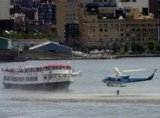 A personal phone call during last week’s collision over New York’s Hudson River has led to two air traffic controllers being removed from duty, although officials said the conversation probably had no impact on the tragedy. The Federal Aviation Administration said in a statement Thursday that a controller at Teterboro Airport in New Jersey and his supervisor have been placed on administrative leave because the controller was involved in “apparently inappropriate conversations” at the time of the crash between a small plane and a tour helicopter that killed nine people. The FAA released the following statement:
A personal phone call during last week’s collision over New York’s Hudson River has led to two air traffic controllers being removed from duty, although officials said the conversation probably had no impact on the tragedy. The Federal Aviation Administration said in a statement Thursday that a controller at Teterboro Airport in New Jersey and his supervisor have been placed on administrative leave because the controller was involved in “apparently inappropriate conversations” at the time of the crash between a small plane and a tour helicopter that killed nine people. The FAA released the following statement:
“In conjunction with the FAA’s participation in the National Transportation Safety Board’s inquiry into the recent Hudson River accident, we learned that the controller handling the Piper flight was involved in apparently inappropriate conversations on the telephone at the time of the accident.
“We also learned that the supervisor was not present in the building as required. While we have no reason to believe at this time that these actions contributed to the accident, this kind of conduct is unacceptable and we have placed the employees on administrative leave and have begun disciplinary proceedings.
“We respect the NTSB’s authority in determining the cause of the accident and will continue to work closely with NTSB investigators.”
The two employees, who were not identified, were placed on administrative leave with pay. The FAA said it has begun disciplinary proceedings against the pair. Three members of a Pennsylvania family on the plane and five Italian tourists and a pilot on the helicopter were killed when the two stricken aircraft plunged into the river.
The controller had cleared the small plane, a single-engine Piper, for takeoff and then made a personal call, said sources familiar with the investigation, who asked not to be named because they weren’t authorized to speak publicly.
While still on the phone, the controller handed off the Piper to the control tower at Newark Liberty International Airport, which monitors low-flying air traffic over the Hudson but doesn’t actively try to keep aircraft separated, they said. The controller was still on the phone when the accident occurred. This sequence of events lasted only a few minutes.
National Transportation Safety Board and FAA investigators learned of the telephone conversation earlier this week while examining recordings of telephone calls on a landline phone in the tower that controllers use to communicate with other parts of the Teterboro Airport. The controller and supervisor were removed from duty immediately.
Air traffic controllers are expected to be alert at all times while on duty and typically are given about a 15-minute break roughly every two hours for that reason.
The National Air Traffic Controllers Association, the labor union representing controllers, said in a statement that it supports a full investigation of the allegations “before there is a rush to judgment.”
The FAA’s action came as an amateur video surfaced that captured the moment of impact between the two aircraft. The images, taken by an Italian man practicing with a new camera while on a boat tour, show the helicopter flying overhead when suddenly a single-engine plane appears behind it, apparently climbing and turning. The plane clips the helicopter’s rotor blades, and a wing shears off. Debris rains down, and the plane flips. Both aircraft fall toward the water.
On the video, aired Thursday on “NBC Nightly News,” one or more onlookers can be heard in the background saying, “Oh, my God!”
Teterboro Airport, located directly across the Hudson River from New York City near the George Washington Bridge, handles corporate and private aircraft.
It is operated by the Port Authority of New York and New Jersey and handles nearly 200,000 flights a year.
In the wake of the tragic crash, the FAA is considering requiring more safety measures for low-flying aircraft in the New York City, FAA Administrator Randy Babbitt said Thursday.
The FAA has already sent pilots a reminder on several long-recommended precautions for flying in the visual flight zone in the congested Hudson River corridor on the west side of Manhattan.
Among them are tuning radios to frequencies where the pilots communicate with one another, flying at speeds under 140 knots and turning on aircraft lights.
Babbitt, speaking after touring the FAA Technical Center at Atlantic City International Airport, said the radio communications might have prevented the crash between a small plane and a sightseeing helicopter.
“They were given traffic alerts,” he said. “However, neither of the pilots was on the frequencies.”
Babbitt said his agency has been helping the National Transportation Safety Board, which is investigating the crash.
He said that while his agency will review any recommendations the NTSB makes, it will also make rule changes sooner if it sees a need.
The FAA has already formed a task force to study issues for the congested areas where visual flight rules apply at low altitudes, Babbitt said.
The crash happened at about 1,100 feet, a space between the lower level where visual flight rules apply and the higher altitude where air traffic controllers guide pilots.
{CBS Broadcasting/Matzav.com Newscenter}











